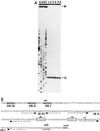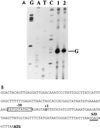Functional analyses of the promoters in the lantibiotic mutacin II biosynthetic locus in Streptococcus mutans
- PMID: 9925596
- PMCID: PMC91075
- DOI: 10.1128/AEM.65.2.652-658.1999
Functional analyses of the promoters in the lantibiotic mutacin II biosynthetic locus in Streptococcus mutans
Abstract
The lantibiotic bacteriocin mutacin II is produced by the group II Streptococcus mutans. The mutacin II biosynthetic locus consists of seven genes, mutR, -A, -M, -T, -F, -E, and -G, organized as two operons. The mutAMTFEG operon is transcribed from the mutA promoter 55 bp upstream of the translation start codon for MutA, while the mutR promoter is 76 bp upstream of the mutR structural gene. Expression of the mutA promoter is regulated by the components of the growth medium, while the mutR promoter activity does not seem to be affected by these conditions. Inactivation of mutR abolishes transcription of the mutA operon but does not affect its own promoter activity. The expressions of both mutA and mutR promoters are independent of the growth stage, while the production of mutacin II is only elevated at the early stationary phase. Taken together, these results suggest that expression of the mutacin operon is regulated by a complex system involving transcriptional and posttranscriptional or posttranslational controls.
Figures








Similar articles
-
Purification of mutacin III from group III Streptococcus mutans UA787 and genetic analyses of mutacin III biosynthesis genes.Appl Environ Microbiol. 1999 Sep;65(9):3880-7. doi: 10.1128/AEM.65.9.3880-3887.1999. Appl Environ Microbiol. 1999. PMID: 10473390 Free PMC article.
-
The specific genes for lantibiotic mutacin II biosynthesis in Streptococcus mutans T8 are clustered and can be transferred en bloc.Appl Environ Microbiol. 1999 Mar;65(3):1356-60. doi: 10.1128/AEM.65.3.1356-1360.1999. Appl Environ Microbiol. 1999. PMID: 10049909 Free PMC article.
-
Transcriptional analysis of mutacin I (mutA) gene expression in planktonic and biofilm cells of Streptococcus mutans using fluorescent protein and glucuronidase reporters.Oral Microbiol Immunol. 2004 Aug;19(4):252-6. doi: 10.1111/j.1399-302X.2004.00148.x. Oral Microbiol Immunol. 2004. PMID: 15209996
-
Diacylglycerol kinase is involved in regulation of expression of the lantibiotic mutacin II of Streptococcus mutans.J Bacteriol. 1998 Jan;180(1):167-70. doi: 10.1128/JB.180.1.167-170.1998. J Bacteriol. 1998. PMID: 9422608 Free PMC article.
-
LuxS controls bacteriocin production in Streptococcus mutans through a novel regulatory component.Mol Microbiol. 2005 Aug;57(4):960-9. doi: 10.1111/j.1365-2958.2005.04733.x. Mol Microbiol. 2005. PMID: 16091037
Cited by
-
The transcriptional regulator RovS controls the attachment of Streptococcus agalactiae to human epithelial cells and the expression of virulence genes.Infect Immun. 2006 Oct;74(10):5625-35. doi: 10.1128/IAI.00667-06. Infect Immun. 2006. PMID: 16988238 Free PMC article.
-
Molecular Determinants of Substrate Selectivity of a Pneumococcal Rgg-Regulated Peptidase-Containing ABC Transporter.mBio. 2020 Feb 11;11(1):e02502-19. doi: 10.1128/mBio.02502-19. mBio. 2020. PMID: 32047125 Free PMC article.
-
Peptide pheromone signaling in Streptococcus and Enterococcus.FEMS Microbiol Rev. 2014 May;38(3):473-92. doi: 10.1111/1574-6976.12046. Epub 2013 Oct 31. FEMS Microbiol Rev. 2014. PMID: 24118108 Free PMC article. Review.
-
The response regulator ComE in Streptococcus mutans functions both as a transcription activator of mutacin production and repressor of CSP biosynthesis.Microbiology (Reading). 2007 Jun;153(Pt 6):1799-1807. doi: 10.1099/mic.0.2007/005975-0. Microbiology (Reading). 2007. PMID: 17526837 Free PMC article.
-
Characterization of a Signaling System in Streptococcus mitis That Mediates Interspecies Communication with Streptococcus pneumoniae.Appl Environ Microbiol. 2019 Jan 9;85(2):e02297-18. doi: 10.1128/AEM.02297-18. Print 2019 Jan 15. Appl Environ Microbiol. 2019. PMID: 30389765 Free PMC article.
References
-
- Bibb M. The regulation of antibiotic production in Streptomyces coelicolor A3(2) Microbiology. 1996;142:1335–1344. - PubMed
-
- Caufield P W, Chen P, Qi F, Novak J. Presented at the 5th Conference on Streptococcal Genetics, Vichy, France. 1998.
-
- Chen P, Novak J, Qi F, Caufield P W. Presented at the Third International Workshop on Lantibiotics and Related Modified Antibiotic Peptides, Blaubeuren, Germany. 1998.
Publication types
MeSH terms
Substances
Associated data
- Actions
- Actions
- Actions
Grants and funding
LinkOut - more resources
Full Text Sources
Other Literature Sources

